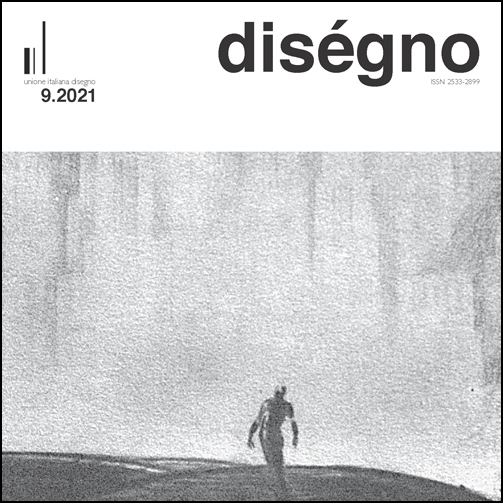Visions of Far Places and Overlaying Illusions: the Gothic Fresco by Pisanello in Verona as a Graphic Crossing in Space and Time
DOI:
https://doi.org/10.26375/disegno.9.2021.14Parole chiave:
Fictional Cities, Gothic Painting, Church of St. Anastasia, San Giorgio, TrebisondaAbstract
In the Church of St. Anastasia, in Verona, Italy, there is a fresco from Pisanello, dated between 1432 and 1438. It is named San Giorgio e la Principessa (St. George and the Princess), but it has received in time the final addition “of Trebisonda”. The vision depicted inside this fresco opens a reflection about interpretation and representation, about resolution and dissolution of reality. The work of representation can be a way of visualizing an idea or a place from which there is just a vision coming from the words of others. No matter how uncertain it is, the vision of the author leads to the definition of the result, capturing myths and fascinations, like ‘the East’, ‘the city far away’, ‘Trebisonda’, ‘the travel’. The traces inserted in the artwork may contain a specific code, later (mis)interpreted in a new cultural scenario. The idea of Pisanello depicting the city on the Black Sea is not supported by resolutive evidence. It seems like a weird alchemy pushing ideas. In this paper, a ‘state of the knowledge’ about this artwork will be the frame for a reflection about the visionary contents and elements in the main scene and in the background. A test operated with a group of architecture students and artists will investigate what happens when representing a city in a landscape seen only through oral communication. A graphic and logical matching between the ideal representation of the city in the fresco and the past and present Trebisonda/Trebizond/Trabzon will complete the analysis.
Riferimenti bibliografici
Avena, A. (1947). Capolavori della Pittura Veronese, Catalogo Illustrato della Mostra, Castelvecchio.Verona: Albarelli.
Bernasconi, C. (1862). Il Pisano, Grand’Artefice Veronese: della Prima Metà del Secolo Decimoquinto considerato primieramente come Pittore e di poi come Scultore in Bronzo Memorie. Verona: Tipografia Civelli.
Bismara, C. (2013). La cappella Pellegrini e Pisanello civis originarius di Verona nel 1438. In Verona Illustrata, Rivista del Museo di Castelvecchio, No. 26, pp. 5-14.
Bryer, A. (1962). Pisanello and the Princess of Trebizond. In Apollo: the international magazine of arts, 76, pp. 601-603.
Bryer, A., Winfield, W. (1985). The Byzantine Monuments and Topography of the Pontos. Washington, D.C.: Dumbarton Oaks Research Library and Collection.
Carlotti, M. (2010). Il bene di tutti. Gli affreschi del buon governo di Ambrogio Lorenzetti nel Palazzo Pubblico di Siena. Firenze: Società Editrice Fiorentina.
Castelfranchi Vegas, L. (1966). Il Gotico Internazionale in Italia. Roma: Ed. Riuniti.
De Vecchi, P., Cerchiari, E. (1999). I Tempi dell’Arte.Vol. 2, Milano: Bompiani.
Eastmond, A. (2004). Art and identity in thirteenth-century Byzantium Hagia Sophia and the empire of Trebizond. Aldershot: Ashgate.
Fossi Todorow, M. (1959). The Exhibition “Da Altichiero a Pisanello” in
Verona. In The Burlington Magazine,Vol. 101, No. 670, pp. 10-14.
Franco,T., Molteni, M. (1996). Dipinti autografi, San Giorgio e la Principes- sa. In L. Puppi (Ed.), Pisanello, Una poetica dell’inatteso, pp. 76-89. Cinisello Balsamo: Silvana Editoriale.
Giura, G. (2016). Spinello Aretino e la Sacrestia di Santa Croce. In I. Droandi (Ed.), “In Nome di Buon Pittore” Spinello e il Suo Tempo, Atti della giornata di studio in memoria di Luciano Bellosi, pp. 73-84. Firenze: Edifir.
Groat, L. N., Wang, D. (2013). Architectural Research Methods. Indianapolis: John Wiley & Sons.
Gyllenbok, J. (2018). Encyclopaedia of Historical Metrology, Weights, and
Measures, 3 Vols. Birkhäuser, New York: Springer Nature.
Karpov, S.P. (1986). L’impero di Trebisonda Venezia Genova e Roma 1204-1461: rapporti politici, diplomatici e commerciali. Roma: Il Veltro.
Le Goff, J. (2011). À la recherche du temps sacré. Paris: Perrin.
Lubbock, T. (2009, January 23). Great Works: City by the Sea (c.1340) Ambrogio Lorenzetti. <https://www.independent.co.uk/arts-entertainment/art/great-works/great-works-city-by-the-sea-c-1340-ambrogio- lorenzetti-1501281.html> (accessed 2021, December 10).
Marini, P., Campanella, C. (a cura di). (2011). La Basilica di Santa Anastasia a Verona. Storia e restauro. Suzzara: Banco Popolare-Gruppo Bancario.
Melucco Vaccaro, A. (1991). Arezzo. Il colle del Pionta, il contributo archeologico alla storia del primitivo gruppo cattedrale. Arezzo: Provincia, Progetto archeologia.
Melville, C. (Ed.). (2012). Persian Historiography: A History of Persian Literature. London: Bloomsbury Publishing.
Pelta, A. (1992). Pisanello’s “Saint George and the Dragon”: Poetic imagination, chivalric tradition, and political destiny in Verona. PhD Thesis, University of Pennsylvania.
Puppi, L. (1982). Verso Gerusalemme. Immagini e temi di urbanistica e di architettura simboliche. Roma-Reggio Calabria: Casa del Libro.
Puppi, L. (1996). Pisanello, Una poetica dell’inatteso. Cinisello Balsamo: Silvana Editoriale.
Ronchey, S. (2012). L’enigma di Piero. Milano: Rizzoli.
Thode, H. (2003). Francesco d’Assisi e le origini dell’arte del Rinascimento in Italia. Roma: Donzelli Editore.
Tournefort, J. (1717). Relation d’un voyage du Levant... contenant l’histoire ancienne & moderne de plusieurs isles de l’Archipel, de Constantinople, des côtes de la Mer Noire, de l’Arménie, de la Georgie, des frontières de Perse & de l’Asie Mineure. Paris: de l’Imprimerie Royale.
Vasari, G. (2015). Le vite de’ più eccellenti architetti, pittori, et scultori italiani, da Cimabue insino a’ tempi nostri. Nell’edizione per i tipi di Lorenzo Torrentino, Firenze 1550. A cura di L. Bellosi, A. Rossi, G. Previtali. Torino: Einaudi.
##submission.downloads##
Pubblicato
Come citare
Fascicolo
Sezione
Licenza
Copyright (c) 2021 diségno

TQuesto lavoro è fornito con la licenza Creative Commons Attribuzione 4.0 Internazionale.






